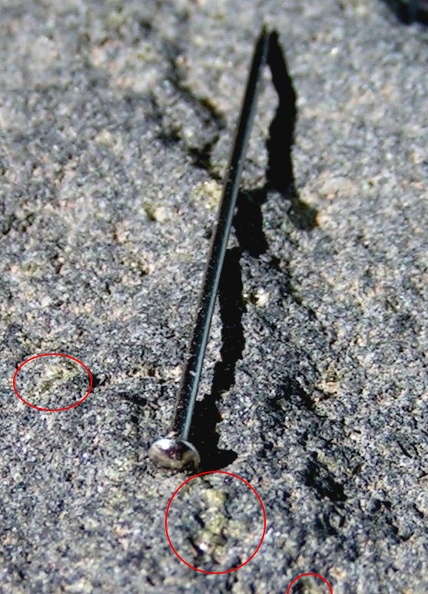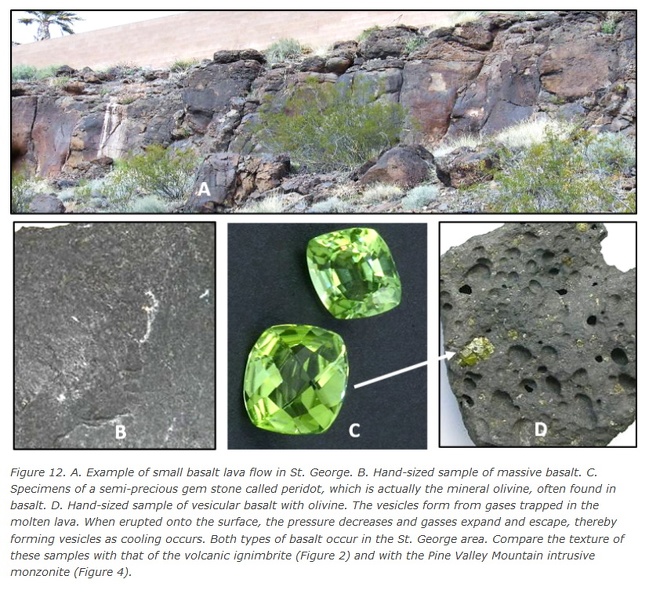|
|
Post by 1dave on Feb 24, 2020 14:21:23 GMT -5
I have long been interested in the volcano just north of Enoch and west of I-15 in Iron County Utah.   A Google Earth look:  Some Dimensions:   It has a diameter of five miles, and the highest point is 1,358 feet higher than UT130 Minersville Highway. There is a graveled road the the last gasp eruption - the small volcanic cone shown on the geology map.  I wish I had gathered more of the black cinders with the open iridescent bubbles!  |
|
|
|
Post by knave on Feb 24, 2020 14:31:52 GMT -5
None of the pictures are working for me.
|
|
|
|
Post by 1dave on Feb 24, 2020 14:40:00 GMT -5
Yeah, there seems to be a problem with RockShow.
|
|
|
|
Post by 1dave on Feb 24, 2020 14:44:41 GMT -5
I pasted the first one to Pinterest -  |
|
|
|
Post by 1dave on Feb 24, 2020 14:51:26 GMT -5
|
|
Deleted
Deleted Member
Member since January 1970
Posts: 0
|
Post by Deleted on Feb 24, 2020 17:37:42 GMT -5
Looks like there has been some cinder mining there. I find the iridescent lava bubbles fascinating. There can be some weird lava formations out there.
|
|
RWA3006
Cave Dweller 
Member since March 2009
Posts: 4,633 
|
Post by RWA3006 on Feb 24, 2020 18:57:02 GMT -5
That area is really interesting along with the Mineral Mountains. I've spent many a happy hour roaming that place and still have a lot to learn about it.
|
|
|
|
Post by 1dave on Feb 26, 2020 16:12:10 GMT -5
Looks like there has been some cinder mining there. I find the iridescent lava bubbles fascinating. There can be some weird lava formations out there. The BLM has been selling permits to use the material as road base etc. for years. The RockShow images are back so I deleted the doubles.  Some SUU geologists discovered RE Elements in the bubbles! The road there -  |
|
|
|
Post by greig on Feb 26, 2020 16:54:17 GMT -5
Very cool. Thanks for sharing
|
|
|
|
Post by Starguy on Feb 27, 2020 11:48:33 GMT -5
Very interesting 1dave Do you know what RE elements they found? Some of those elements are fascinating. Here’s a YouTube video on neodymium magnets. This thing is impressive. link |
|
|
|
Post by 1dave on Feb 27, 2020 16:02:49 GMT -5
Very interesting 1dave Do you know what RE elements they found? Some of those elements are fascinating. Here’s a YouTube video on neodymium magnets. This thing is impressive. I can't find the article I read 4-5 years ago, but: www.researchgate.net/publication/279962510_RARE_EARTH_ELEMENT_PROSPECTS_AND_OCCURRENCES_IN_UTAHpage 26 (31 in the PDF) states: The largest and most important ore bodies are stratabound replacement ores in the Middle Jurassic Homestake Limestone Member of the Carmel Formation surrounding the laccoliths. The replacement ore bodies are tabular, pod-shaped deposits in limestone along the igneous contacts, coinciding with zones of strong jointing in the underlying quartz monzonite. In form, the replacement deposits resemble skarns, but their general lack of calc-silicate development has resulted in the deposits being referred to as replacement bodies. The principal gangue minerals are calcite, apatite, quartz, and muscovite (Wray and Pedersen, 2009). The Comstock-Mountain Lion deposit is a prime example of the stratabound replacement type deposit (Bullock, 1970). Apatite is the primary known REEbearing phase in the Iron Springs ores and apatite is more common in the veins. Adams (1969) reports REE-bearing apatite from the Smith Fe mine on the southern flank of the Three Peaks laccolith. Historic concentrate production has averaged about 1 weight (wt) % apatite or about 0.42% P2O5, but rare individual ore assays show as much as 7.8% P2O5, equivalent to over 18 wt % apatite. Since phosphate is a deleterious constituent for steel making, it is possible that some of the existing dumps may contain high P2O5 grades. Barker (1995) reports strong REE values in apatites from the veins including (table 6). The Iron Springs REE analyses are strongly enriched in the LREE. Several partial SITLA sections are present in the Iron Springs mining district. In large part, these tracts are incomplete due to the presence of patented mining claims which appear to cover the more favorable ground for Fe resources. |
|
|
|
Post by 1dave on Feb 28, 2020 10:52:50 GMT -5
Most of the rocks on MY volcano are Olivine Basalt, BUT -  They must have come from a shallow magma with very little magnesium because I haven't found olivine (peridot) crystals much larger than pin heads.  Deeper magmas produce larger crystals.   "Tholeiite" is just from the name of the town where it was first described.
It is just basic basalt exactly like what is extruded at mid ocean fissures.
Really deep ones like Hawaii can be eye-popping!   |
|